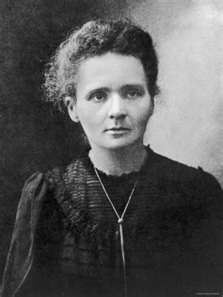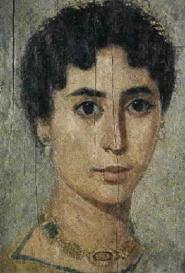Marie and Pierre Curie were both people who preferred to stay out of the limelight. As their fame grew, Marie probably adjusted to the attention better than Pierre did, but doing the work of science was foremost for both of them. Pierre still had a low level position in one of the less prestigious schools in Paris even though he had friends who worked to try to get him a position at the Sorbonne. Marie had finished her work on magnetism and began to look around for a topic for her doctoral thesis. They took a small apartment, Pierre took on more tutoring work and Marie got her teaching certification. Their income was small, but they could make it.
During this time, there was a series of discoveries which would set the stage for the work which would bring Marie Curie her fame. Conrad Röntgen discovered X-rays. The exact nature of this radiating energy was unknown, but a connection was hypothesized between X-rays and phosphorescence. Henri Becquerel, with an interest in phosphorescence, experimented to determine whether or not other minerals known to be florescent produced X-rays. After testing many different minerals, the only one which exhibited a similar type of radiating energy was uranium.
The discovery of X-rays created quite a stir, particularly with its implications for medicine, so of course the Curie’s followed the related research. Marie thought that uranium and this radiating energy were of interest and decided to investigate further. By examining ore samples containing uranium, she determined that the amount of radiation was directly related to the amount of uranium in the sample. It wasn’t affected by other factors such as temperature or other elements contained in the sample. This led her to hypothesize that the radiation was a characteristic of the atom itself.
One of the minerals that she investigated was pitchblende. Here she measured much higher levels of radiation than could be accounted for by uranium. She concluded that there must be additional elements within pitchblende that also exhibited this property of radiating energy and began the long and tedious process of isolating and identifying them. She coined the term radioactivity and established the science that would be used to analyze it.
It is important to remember that other scientists were actively involved in similar investigations. Becquerel had in fact discovered, and maybe more importantly, published the concept of radioactivity first. In Marie’s experiments she discovered that the element thorium was radioactive, but Gerhard Schmidt in Germany had discovered the same thing and published it earlier. Marie knew of the importance of announcing and publishing her work in a timely fashion. Since, neither she nor Pierre were members of the French Academy of Science, her former professor Gabriel Lippman presented her first paper on the subject for her in 1898.
It took about four years for Marie to complete her work. She isolated two radioactive elements in pitchblende: polonium and radium. At some point, Pierre put his work aside and began to work with her, as did other scientists and students. Much of the work, especially at the beginning, required back breaking effort. As it turns out, they had to process from 6- 7 tons of pitchblende to get a miniscule amount of radium. Radium is the element that caught the imagination of the world and would be used in things from paint on watch dials to “health” drinks, much to the detriment of those that came in close contact with it.
During this period of time, Marie gave birth to their first daughter, Irene, in 1897. It was, of course, expected that a woman would take care of everything related to the home. When Marie and Pierre were married, their home and lives were simple. It is said that they only had two chairs at their table to discourage visitors from staying. In the evening, they would companionably read physics together. They had a shared obsession with science that overshadowed everything else. When Irene was born this changed dramatically.
Marie went back to her work, but would have to rush home to nurse Irene. She didn’t have enough milk and had to hire a wet nurse. With two nurses to care for the baby, their meager income was stretched even more. With the hard physical work she was doing, the increased expenses, and the feeling of failure at not being able to nurse her baby, the stress took its toll on Marie’s health. Pierre’s father came to the rescue. Dr. Eugene Curie was the physician who had delivered Irene. During the same month, his wife, Pierre’s mother died of breast cancer. So, at the beginning of 1898, Dr. Curie moved in with Marie and Pierre to care for Irene.
Dr. Curie was a godsend. He was a warm, expressive man who Irene and later Eve would remember fondly. He is probably responsible for meeting most of their emotional needs. There is no doubt that Marie loved her children, but she and Pierre were in many ways lost in their scientific world. And after Pierre died in 1906, Marie would close herself off emotionally, preventing them from even mentioning Pierre’s name in her presence.
Pierre had been denied the acclaim in France that he had received internationally, in part due to his unconventional background, and Marie faced these kinds of prejudices as well because she was a woman. By 1902, she had isolated enough radium to determine its place on the periodic table and to satisfy the chemists that it was indeed a new element. She wrote her thesis and received her doctorate and in 1903, Marie, Pierre, and Henri Becquerel were nominated for and received the Nobel Prize in physics.
It wasn’t quite that simple though. The Nobel Prizes were first given beginning in 1901. That first year, and again in 1902, Charles Bouchard nominated all three of them. Other people were chosen both years. Then in 1903 four influential scientists, including Gabriel Lippman, Marie’s former professor whom she considered a friend, nominated Henri Becquerel and Pierre Curie for the physics prize with no mention of Marie. Magnus Gustaf Mittag-Leffler a respected Swedish mathematician who was on the nominating committee told Pierre of the nomination. Pierre wrote him that he would not accept the prize unless Marie was included. He approached the committee with this letter, and with the support of Charles Bouchard, the nomination was changed to include Marie.
(Mittag Leffler believed that women were under appreciated in the sciences. He was also the person responsible for raising the private funds to support the appointment of Sonya Kovalevsky to a position of full professor in mathematics at his university in Sweden. She was the first woman to become a professor of mathematics and Marie Curie the first woman to become a Nobel Prize winner. Thank you Professor Leffler!)
Life changed after the Nobel Prize. Although, the Curie’s had not patented their process for extracting radium, they did receive some income from it due to its immense popularity, but probably not enough to make up for the time they had to spend dealing with other people. They had made this choice on principle believing that it was more important to facilitate the work of science than to profit from it.
In 1904 Pierre was finally offered a chair at the Sorbonne, the same year a second daughter, Eve, was born. And in 1905, he was offered membership in the French Academy of Science. The latter came with lab facilities and three posts, one of which he gave to Marie. Then tragedy struck in 1906, when Pierre fell in the street and was struck in the head and died.
Pierre’s death changed Marie. Joy and light seemed to be taken from her. Dr. Curie sustained his granddaughters and taught them about their father, because Marie refused to discuss him after his death. This would be especially important for Eve since she was less than two years old when he died. Marie would be actively involved in their lives, planning their education and being with them, but it was never the same.
Life is complicated and it is difficult if not impossible to determine cause and effect in many areas of our lives. But Pierre Curie understood his wife in a way that I’m not sure anyone else did. Her drive to study science was probably motivated by several things, interest and ability of course, but possibly a need to do the things that had been denied her father, as well as a need to retreat from every day life when depression threatened to overwhelm her.

It’s also impossible to give an accurate picture of a complicated person in 3000 words or less. Marie went on to become a professor at the Sorbonne in 1908 and win the 1911 Nobel Prize in Chemistry for her discovery of radium, an award that was almost derailed because of an affair with Paul Langevin. (This, in itself, is a study of how women were treated differently even in the “rational” world of science. The same standard certainly wasn’t applied to Langevin or to Einstein for that matter.) She oversaw the building of The Curie Institute, developed and implemented mobile X-ray machines during World War I, and even got involved in a little intrigue to prevent the Germans from getting their hands on radium during the war.
Marie continued to teach young scientists, although she would do no more original work of the caliber she did in her early life. Some (at least at the time) would try to claim this as evidence that Pierre was the real scientist of the two, but I don’t think this is the case. Many scientists do their best work at an early age. I think they were both exceptional scientists with individual accomplishments and an understanding of each other that brought out the best of each.
Note: The next woman to win a Nobel Prize would be Marie and Pierre’s daughter, Irene Joliot-Curie with her husband Frederic Joliot-Curie in 1935, the year after Marie’s death.
Read about Marie’s early life.
Resources
Obsessive Genius: The Inner World of Marie Curie by Barbara Goldsmith
Six Great Scientists by J. G. Crowther








